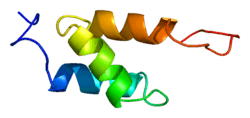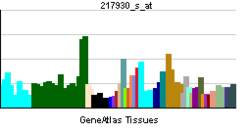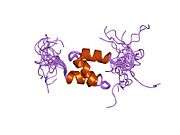TOLLIP
| View/Edit Human | View/Edit Mouse |
Toll interacting protein, also known as TOLLIP, is an inhibitory adaptor protein that in humans is encoded by the TOLLIP gene.[3][4][5]
Function
It is an inhibitory adaptor protein within Toll-like receptors (TLR).[6] The TLR pathway is a part of the innate immune system that recognizes structurally conserved molecular patterns of microbial pathogens, leading to an inflammatory immune response.
Clinical significance
Polymorphisms in TLR genes have been implicated in various diseases like atopic dermatitis.[7] Recently, variations in the TOLLIP gene have been associated with tuberculosis and idiopathic pulmonary fibrosis.[8][9]
Interactions
TOLLIP has been shown to interact with TOM1,[10] TLR 2,[11] TLR 4[11] and IL1RAP.[5]
References
- ↑ "Human PubMed Reference:".
- ↑ "Mouse PubMed Reference:".
- ↑ "Entrez Gene: TOLLIP toll interacting protein".
- ↑ Volpe F, Clatworthy J, Kaptein A, Maschera B, Griffin AM, Ray K (December 1997). "The IL1 receptor accessory protein is responsible for the recruitment of the interleukin-1 receptor associated kinase to the IL1/IL1 receptor I complex". FEBS Lett. 419 (1): 41–4. doi:10.1016/S0014-5793(97)01426-9. PMID 9426216.
- 1 2 Burns K, Clatworthy J, Martin L, Martinon F, Plumpton C, Maschera B, Lewis A, Ray K, Tschopp J, Volpe F (June 2000). "Tollip, a new component of the IL-1RI pathway, links IRAK to the IL-1 receptor". Nat. Cell Biol. 2 (6): 346–51. doi:10.1038/35014038. PMID 10854325.
- ↑ Bulut Y, Faure E, Thomas L, Equils O, Arditi M (July 2001). "Cooperation of Toll-like receptor 2 and 6 for cellular activation by soluble tuberculosis factor and Borrelia burgdorferi outer surface protein A lipoprotein: role of Toll-interacting protein and IL-1 receptor signaling molecules in Toll-like receptor 2 signaling". J. Immunol. 167 (2): 987–94. doi:10.4049/jimmunol.167.2.987. PMID 11441107.
- ↑ Schimming TT, Parwez Q, Petrasch-Parwez E, Nothnagel M, Epplen JT, Hoffjan S (2007). "Association of toll-interacting protein gene polymorphisms with atopic dermatitis". BMC Dermatol. 7: 3. doi:10.1186/1471-5945-7-3. PMC 1832210
 . PMID 17362526.
. PMID 17362526. - ↑ "Human TOLLIP Regulates TLR2 and TLR4 Signaling and Its Polymorphisms Are Associated with Susceptibility to Tuberculosis". J Immunol. 189 (4): 1737–46. 2012. doi:10.4049/jimmunol.1103541.
- ↑ "Genetic variants associated with idiopathic pulmonary fibrosis susceptibility and mortality: a genome-wide association study". The Lancet Respiratory Medicine. 1 (4): 309–317. doi:10.1016/S2213-2600(13)70045-6.
- ↑ Yamakami, Megumi; Yoshimori Tamotsu; Yokosawa Hideyoshi (Dec 2003). "Tom1, a VHS domain-containing protein, interacts with tollip, ubiquitin, and clathrin". J. Biol. Chem. United States. 278 (52): 52865–72. doi:10.1074/jbc.M306740200. ISSN 0021-9258. PMID 14563850.
- 1 2 Zhang, Guolong; Ghosh Sankar (Mar 2002). "Negative regulation of toll-like receptor-mediated signaling by Tollip". J. Biol. Chem. United States. 277 (9): 7059–65. doi:10.1074/jbc.M109537200. ISSN 0021-9258. PMID 11751856.
Further reading
- Nilsen KH (1976). "Malignant lymphoma and rheumatic symptoms". N. Z. Med. J. 83 (563): 320–2. PMID 1085432.
- Volpe F, Clatworthy J, Kaptein A (1998). "The IL1 receptor accessory protein is responsible for the recruitment of the interleukin-1 receptor associated kinase to the IL1/IL1 receptor I complex". FEBS Lett. 419 (1): 41–4. doi:10.1016/S0014-5793(97)01426-9. PMID 9426216.
- Burns K, Clatworthy J, Martin L (2000). "Tollip, a new component of the IL-1RI pathway, links IRAK to the IL-1 receptor". Nat. Cell Biol. 2 (6): 346–51. doi:10.1038/35014038. PMID 10854325.
- Hartley JL, Temple GF, Brasch MA (2001). "DNA Cloning Using In Vitro Site-Specific Recombination". Genome Res. 10 (11): 1788–95. doi:10.1101/gr.143000. PMC 310948
 . PMID 11076863.
. PMID 11076863. - Wiemann S, Weil B, Wellenreuther R (2001). "Toward a Catalog of Human Genes and Proteins: Sequencing and Analysis of 500 Novel Complete Protein Coding Human cDNAs". Genome Res. 11 (3): 422–35. doi:10.1101/gr.GR1547R. PMC 311072
 . PMID 11230166.
. PMID 11230166. - Bulut Y, Faure E, Thomas L (2001). "Cooperation of Toll-like receptor 2 and 6 for cellular activation by soluble tuberculosis factor and Borrelia burgdorferi outer surface protein A lipoprotein: role of Toll-interacting protein and IL-1 receptor signaling molecules in Toll-like receptor 2 signaling". J. Immunol. 167 (2): 987–94. doi:10.4049/jimmunol.167.2.987. PMID 11441107.
- Zhang G, Ghosh S (2002). "Negative regulation of toll-like receptor-mediated signaling by Tollip". J. Biol. Chem. 277 (9): 7059–65. doi:10.1074/jbc.M109537200. PMID 11751856.
- Strausberg RL, Feingold EA, Grouse LH (2003). "Generation and initial analysis of more than 15,000 full-length human and mouse cDNA sequences". Proc. Natl. Acad. Sci. U.S.A. 99 (26): 16899–903. doi:10.1073/pnas.242603899. PMC 139241
 . PMID 12477932.
. PMID 12477932. - Yamakami M, Yoshimori T, Yokosawa H (2004). "Tom1, a VHS domain-containing protein, interacts with tollip, ubiquitin, and clathrin". J. Biol. Chem. 278 (52): 52865–72. doi:10.1074/jbc.M306740200. PMID 14563850.
- Ota T, Suzuki Y, Nishikawa T (2004). "Complete sequencing and characterization of 21,243 full-length human cDNAs". Nat. Genet. 36 (1): 40–5. doi:10.1038/ng1285. PMID 14702039.
- Katoh Y, Shiba Y, Mitsuhashi H (2004). "Tollip and Tom1 form a complex and recruit ubiquitin-conjugated proteins onto early endosomes". J. Biol. Chem. 279 (23): 24435–43. doi:10.1074/jbc.M400059200. PMID 15047686.
- Lehner B, Sanderson CM (2004). "A Protein Interaction Framework for Human mRNA Degradation". Genome Res. 14 (7): 1315–23. doi:10.1101/gr.2122004. PMC 442147
 . PMID 15231747.
. PMID 15231747. - Gerhard DS, Wagner L, Feingold EA (2004). "The Status, Quality, and Expansion of the NIH Full-Length cDNA Project: The Mammalian Gene Collection (MGC)". Genome Res. 14 (10B): 2121–7. doi:10.1101/gr.2596504. PMC 528928
 . PMID 15489334.
. PMID 15489334. - Wiemann S, Arlt D, Huber W (2004). "From ORFeome to Biology: A Functional Genomics Pipeline". Genome Res. 14 (10B): 2136–44. doi:10.1101/gr.2576704. PMC 528930
 . PMID 15489336.
. PMID 15489336. - Ohnuma K, Yamochi T, Uchiyama M (2005). "CD26 Mediates Dissociation of Tollip and IRAK-1 from Caveolin-1 and Induces Upregulation of CD86 on Antigen-Presenting Cells". Mol. Cell. Biol. 25 (17): 7743–57. doi:10.1128/MCB.25.17.7743-7757.2005. PMC 1190283
 . PMID 16107720.
. PMID 16107720. - Rual JF, Venkatesan K, Hao T (2005). "Towards a proteome-scale map of the human protein-protein interaction network". Nature. 437 (7062): 1173–8. doi:10.1038/nature04209. PMID 16189514.
- Mehrle A, Rosenfelder H, Schupp I (2006). "The LIFEdb database in 2006". Nucleic Acids Res. 34 (Database issue): D415–8. doi:10.1093/nar/gkj139. PMC 1347501
 . PMID 16381901.
. PMID 16381901. - Katoh Y, Imakagura H, Futatsumori M, Nakayama K (2006). "Recruitment of clathrin onto endosomes by the Tom1-Tollip complex". Biochem. Biophys. Res. Commun. 341 (1): 143–9. doi:10.1016/j.bbrc.2005.12.156. PMID 16412388.
- Lim J, Hao T, Shaw C (2006). "A protein-protein interaction network for human inherited ataxias and disorders of Purkinje cell degeneration". Cell. 125 (4): 801–14. doi:10.1016/j.cell.2006.03.032. PMID 16713569.
- Brissoni B, Agostini L, Kropf M (2007). "Intracellular trafficking of interleukin-1 receptor I requires Tollip". Curr. Biol. 16 (22): 2265–70. doi:10.1016/j.cub.2006.09.062. PMID 17113392.
This article is issued from Wikipedia - version of the 6/6/2016. The text is available under the Creative Commons Attribution/Share Alike but additional terms may apply for the media files.



